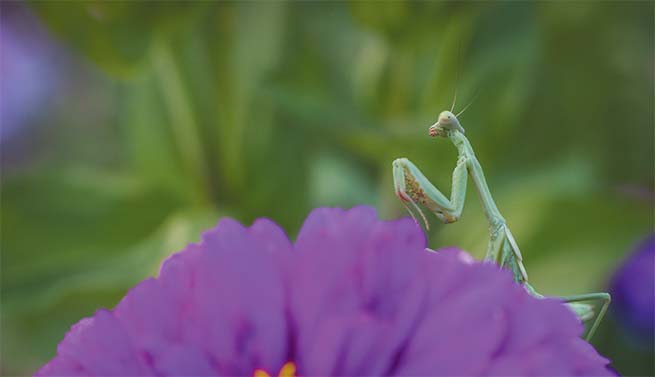
STORY AND PHOTOGRAPHY BY MARSHALL HINSLEY
You might be tempted by an outbreak of aphids or an infestation of grasshoppers to resort to the deadliest weapons you can find at the garden center, but in fact these insecticides will only ensure that you’re locked into using them over and over as the bugs keep coming back.
The problem with all insecticides, organic or synthetic, is that they don’t just kill the bad bugs—they kill the good ones too. That means you’ll have no natural crop protectors left to help your garden plants.
The reproduction rate among so-called bad bugs is much faster than for the good bugs; before ladybug, praying mantis or predatory wasp populations can recover with a new generation, your aphids, squash bugs and cucumber beetles will already be having their great grandchildren. What’s more, pesticides are deadly for wildlife too, killing birds, frogs, lizards and anything else that roams into a treated garden.
The better approach for the backyard gardener is to simply not freak out at the sight of pests. Look at any thriving tomato plant, for instance, and you’ll find aphids. But without pesticides, you’ll also find ladybugs and lacewings keeping them in check. And the plant hosting these dueling populations will be as healthy as any.
What’s more, the aphids in this example will attract wasps to your garden as they exude honeydew, which adult wasps eat. But wasp larvae are carnivores, so their parents have to search out to your garden for caterpillars, which they grab hold of, fly away with and take back to their nests, thus keeping yet another pest issue in your garden under control.
Pesticides also kill spiders, all species of which are nothing but assets in the garden, weaving webs and constructing traps for insects that rival any invention ever dreamed up for bug control. To see a wolf spider, who weaves no web, stalk a grasshopper, catch it and nourish itself on such a huge prey is a sight to see. Jumping spiders are like cats in the garden, roaming under leaves and winding around branches until a bug is in view, which they then pounce on.
Your goal as a backyard gardener, who wants to grow fresh, safe food and enjoy a beautiful garden, is to assist with the balance that inevitably comes to any unhindered ecosystem. Planting flowers to attract bees, butterflies and hummingbirds is one step toward this balance.
By seeking out creative ways to attract all kinds of wildlife into your backyard, you’ll reap the benefits of all the natural functions they perform.
MARSHALL HINSLEY is a writer and photographer who lives with his wife on a 40-acre farm south of Dallas. With a passion for growing sweet, vine-ripe specialty melons, he's also a sustainable farmer whose mission is to grow food crops in a way that improves the ecosystem and benefits wildlife as well.
- Marshall HInsleyhttps://www.edibledfw.com/author/mhinsley/
- Marshall HInsleyhttps://www.edibledfw.com/author/mhinsley/
- Marshall HInsleyhttps://www.edibledfw.com/author/mhinsley/
- Marshall HInsleyhttps://www.edibledfw.com/author/mhinsley/







